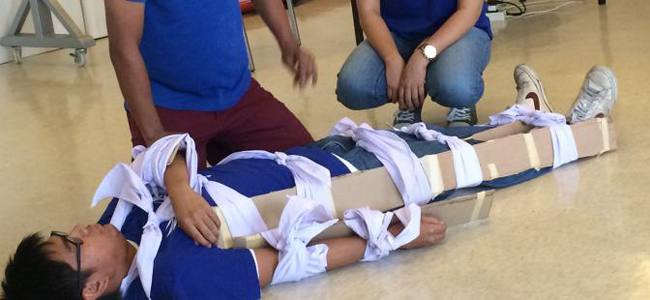
Training Tips: Mummified! (The Triangular bandages)
A fun and effective way to end your bandaging training sessions that will leave your students’ hearts pounding
For the Filipino rescuers, the only equipment more versatile than triangular bandages are their brains. The T-bandages’ uses are limited only by the user’s imagination, ingeniuity, creativity, and sensibility.
My first introduction to the triangular bandage was during my boyscout days, through that green triangular scarf that we so fondly place around our necks. As scouts, we have used that nifty cloth for almost every thing, from lashing poles together, to filtering water, to starting fire, to cooking rice without pots, and of course dressing and bandaging wounds, and splinting fractures and dislocations. You name it, a scout can do it with his scarf!
In first aid and emergency response situations, the triangular bandage becomes an indispensable component of the rescuer’s arsenal, and bandaging an integral part of every medics’ skills. Even with the advent of modern day non-stick gauze, the triangular bandage remains, and will remain to be the most iconic and utilitarian of all our gear. In training, it is also one of the most fun.
Mummified is a surefire ending to a bandaging class where adrenaline, stress management, technique and knowledge is woven into a fun and challenging skills relay. This is how we do it.
1. Make sure you have enough T -Bandages with a ratio of at least one triangular bandage for every pair of student. One bandage per student is even better.
2. Group the students into pairs and have each buddy pair grab a chair and arrange them in an inverted “U” formation, with you front and center.
3. One of the partners (A) gets to be the rescuer and the other partner (B) plays the patient. Have Partner B sit on the chair and let Partner A stand behind.
4. Teach your T-Bandage class as usual with partner A and B alternating as rescuer and patient.
5. When you are already confident with your students’ skills, have the class divide into two groups, Team 1 and Team 2. Have both teams elect their team leaders. Announce that the next exercise will be a competition between the two teams. Give them the whole break time to practice as a team but do not give any hint how it will be done.
The Challenge
1. Form both teams on one end of the classroom, in lines or in clusters. Outdoors is even better.
2. Choose one “patient” from each team. Have the ‘patients’ sit on the floor facing the oppossing team at least 10 paces away.
3. Collect all triangular bandages. Divide the bandages equally among the teams and hand them to the “patients”.
4. Get one volunteer from both teams to go first. Give the first case and let them rip! Repeat until everybody has given a go at it at least once.
5. Find out the winner!
The Rules
1. Everybody participates. Choose the best bandaging students as the “patients”. Patients can neither coach nor speak.
2. Each run has a time limit of one minute. Timer starts as soon as the instructor says go. Runners must return to their teams before the minute ends or their runs will not count. Everbody must take turns. No team member can do a second run until everyone has taken their turns.
3. Points are awarded for a finished, well-dressed and secure bandage on the right body part. No points are are awarded for unfinished and unsecure bandage. No points are awarded for runners who are not able to return to their teams at the end of the one minute time limit. No points are also awarded when the bandages are done on the wrong body part or side.
4. Team members may not help the runners physically but are encouraged to coach.
5. All bandaging techniques are checked after all scenarios are done and not after each run. Done correctly, your “patients” will be mummified at the end of the game.
6. Have fun!
Keypoints:
1. Schedule the lecture and skills practice prior to a scheduled long break, say, before lunch or during the afternoon break.
Bandaging is a life saving skill. Do not skimp on the bandages and manage time well giving priority to the understanding of underlying principles behind bandaging. I have seen classes where students have failed because they were not able to master the square knot. In a real emergency, square knot or not will not matter. People at the emergency department will just cut your Bandage. Roller gauze and other bandages may also be used.
2. Give cases where the extremeties are bandaged first. Bandages to the head and eyes must be done last. Arrange the scenarios in order that bandages do not overlap or cover another bandage, or that the previous bandage do not go in the way of succeeding bandaging techniques.
3. Encourage team members to coach. Everybody shouting all at the same will be very chaotic and will add to the stress of the runners. Let it be. In a real situation, it may be worst and it will be to your students’ advantage that they experience this now. This controlled chaos may help them deal with future responses where it may be more chaotic. Keeping one’s focus and staying calm is the name of the game.
4. Use your imagination.
Sample cases/scenarios:
1. Sprained left ankle
2. Wound on the right palm
3. Wound on the right shin
4. Wound on the right side of the chest
5. Wound on the left thigh
6. Dislocated left shoulder
7. Broken jaw
8. Burned right hand (finger separtors required)
9. Wound on top of the head
10. Wound on the left eye


